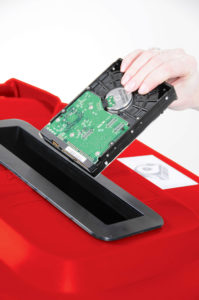How are hard drives destroyed anyway?
Once upon a time, most storage media were what we call magnetic storage. This meant the data was stored on a magnetized medium of some kind. Traditional Hard Disks (HDDs) for example, illustrate this effectively. They use magnetized plates placed on top of each other (called “perpendicular recording”) to store everything from video and audio files to important legal documents. It’s an effective method, and refinements in this technology have led to ever larger (and cheaper) hard disks being developed.
HDDs are, understandably, a huge vector for confidential and sensitive data of all sorts, and often clients ask us to “securely destroy” them. The first thing that probably springs to mind when you hear the words “destroying data” is a reformat of the drive itself. After all, conventional wisdom tells us that digital deletion of data conveys a permanency (as anyone familiar with losing files on older versions of Office would be able to tell you).
The reality is that digital deletion isn’t permanent. What a reformat, or really any digital form of deletion does is delete index tables (essentially the thing that tells the computer where everything on the previous write sits), or if it’s more thorough: write blank data to disk. In both cases, data recovery with off-the-shelf software is relatively straightforward.
Destroying the medium, not the data itself
You may have also heard that passing a magnet over traditional Hard Disks can wipe (or at least corrupt) what sits on them. This is where degaussing comes in. Degaussers are highly specialized pieces of equipment whose purpose is to generate strong magnetic fields. These fields disrupt iron oxide coatings of the plates on the Hard Disk and removing its magnetic induction, making its written data unrecoverable.

Degaussing partially destroys the physical medium. This is important because with virtually all forms of media storage, reformatting, even running several reformats, simply isn’t enough. Destroying the physical media itself is the only 100% guarantee of ensuring data isn’t recoverable. Vital when you’re considering the enormous quantities of data organizations are legally required to destroy.
Enter Solid State
Solid State Hard Drives (SSDs) first entered the mass consumer and enterprise marketplaces in the late 2000s. They’re now widespread in virtually all consumer and OEM enterprise devices. The basic principle of SSDs is that there are no moving parts, as opposed to traditional hard disks, which use a mechanical arm to read and write data.
There are also no magnetized plates to store data, instead, data is stored on microchips. This allows for significantly faster read/write speeds, while using less power (although it’s unlikely we’ll see an end to HDDs anytime soon). Crucially, it means degaussing an SSD doesn’t destroy its data. Much like traditional hard disks, running a reformat on these drives will merely sanitize the drive, not securely destroy the data inside.
In keeping with the approach to destroy the medium, not the data itself, an SSD must be destroyed physically. Because the data is on a series of interconnected microchips, no magnetic field is going to disrupt this.
Instead, there are two primary methods which can be used to destroy SSDs in the same way HDDs are physically destroyed:

- Shredding: You’ve almost certainly heard of shredders before, and how they’re used to destroy office documents. Industrial-grade multimedia shredders usually made up of interlocking grinders, however, offer a lot more scope in terms of what they can shred.
- Crushing: Crushing, or pulverizing, involves using pneumatics to smash an SSD or HDD into pieces. This renders it inoperable.
In both cases, the smaller the pieces that the SSD is broken up into, the more secure the process is and if you’re dealing with high-capacity storage, this is especially pertinent. Following destruction, the remains of the SSD can usually be recycled.
In summary, SSDs can only be physically destroyed, no method of data corruption will work.
The Future of Storage
Technology rarely stays still. We’re seeing several innovative new storage media in their conceptual stages, which we’ll have to consider different destruction methods for. Here’s a brief rundown of just a few:
- Helium Hard Drives:
Helium Hard Drives are not mechanically different to existing HDDs. Their main point of differentiation is in using vacuum-sealed helium within the drive, rather than air, which delivers a host of advantages, such as less drag on the read/write heads on the drive itself.
Helium HDDs are already commercially available, albeit at a cost.
- Shingled Magnetic Recording (SMR):
The “shingling” here refers to the ability of this storage media to store data in a shingled, rather than “perpendicular” way. If you imagine this as how shingling works in a building setting (set at angles to each other), it’s a good approximation. This means the same amount of data can be stored across a narrower space
- Holographic Data Storage
“Holographic” methods of storing data have been around for several decades. Put simply, rather than using the surface of a medium, like a plate or a microchip, to store data, Holographic methods of storage store them throughout the entire volume, by utilizing light in different angles. You’re reading and writing data in three dimensions.
Theoretically, Holographic Data drives can reach enormous storage capacities. One calculation puts it at “1 terabyte (TB)in a sugar-cube-sized crystal.”
New storage media is adapting and innovating to meet the demands of a world where data storage requirements are growing exponentially every year.
Server farms and cloud storage facilities will only grow in importance. Alongside this, public awareness, and international regulation around data destruction is also growing (there are increasing calls for a World Data Organization for example).
Regardless of what future technology becomes standard, it’s important to choose a destruction partner who can advise you on the best approach based on your IT equipment disposal that is sustainable and efficient.
To find out more about secure IT disposal or destruction as it exists now, and how it can help your organization steer clear of fines and worse, get in touch with our experts.





